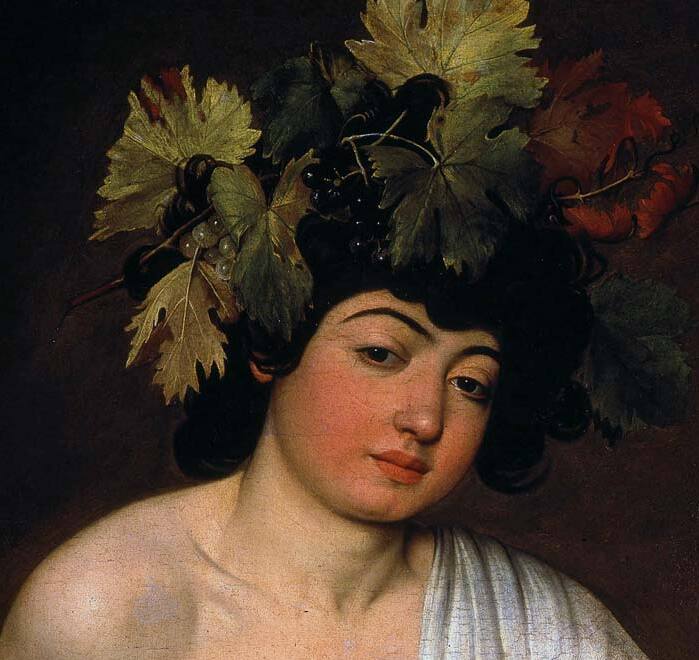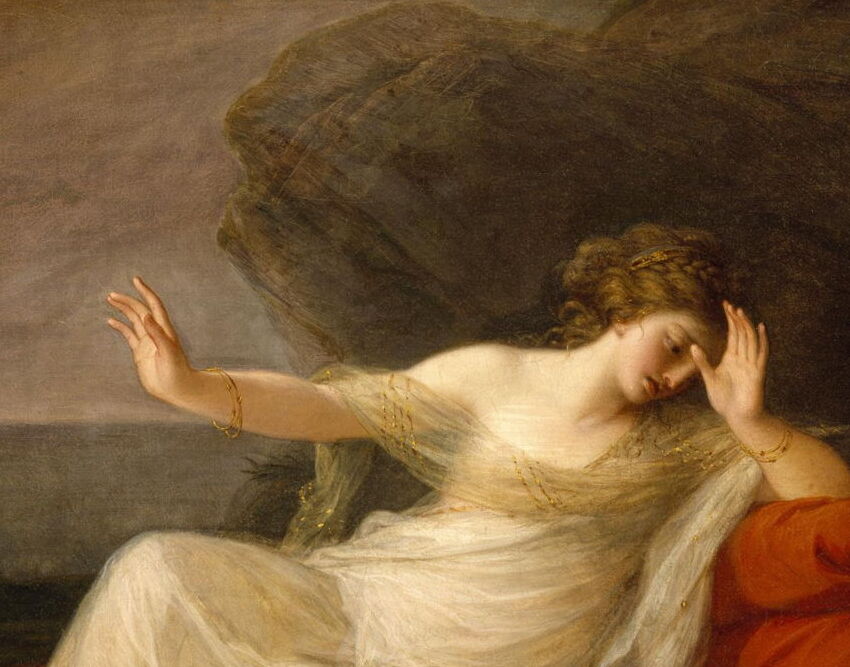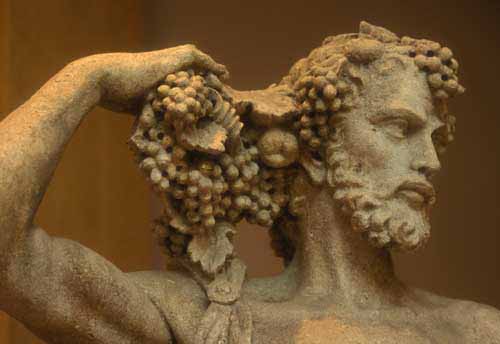Dionysos and Ariadne

For this week’s blogpost leading up to Valentine’s Day, we thought we would share with you a more uplifting story.
Indeed, the love story of Dionysos and Ariadne is one of the rare instances where a mythological episode ends with the much favoured by a 21st century audience happy ending.
As many may know, the ancient Greeks identified Dionysos as the god of Wine and Revelry, of Liminal spaces and drunken orgiastic rites.

Bacchus, Caravaggio (1596)
Ariadne, on the other hand, was the mortal daughter of Minos, king of Crete who ruled the ancient city of Knossos, and his wife Pasiphae. The story of Dionysos and Ariadne has quite a lot of necessary subplot to understand before we move on to their meeting. But, we promise we’ll keep it short and simple.
Theseus and the Minotaur
As is probably known, Aphrodite had cursed Pasiphae to fall in love with a lovely bull which had been sent forth from the sea by Poseidon as a gift to Minos to be sacrificed in his name.
Instead, Minos decided to keep the bull for himself and sacrificed another for Poseidon.
This did not, of course, fool the god who asked for Aphrodite’s help in enacting his revenge. And so, Pasiphae was made to fall in love with the bull and from their union the Minotaur was born.
Theseus, prince of Athens, was sent by his father Aigeus to try and kill the Minotaur so that Athens could be free of the blood tithe they were paying to Minos. Every year Athens would have to send young boys and girls to be eaten by the Minotaur, but one year Theseus was tasked with putting a stop to this.
However, the hero only succeeded with Ariadne’s help, who in the meantime had fallen in love with him and resolved to help him. She gave them the means to navigate the Labyrinth successfully and when Theseus eventually killed the beast and emerged from the Labyrinth, he promised to take Ariadne with him back to Athens and marry her.
Having betrayed her father Ariadne was at least happy she would be able to live with the man she loved.
Ariadne in Naxos

Ariadne Abandoned by Theseus, Angelica Kauffman (1774)
At this point the ancient poets do not all agree as to what happened next. Some say that Theseus never intended to marry Ariadne, and instead abandoned her on the island of Dia (Naxos).
Some others say that Theseus had no choice but to leave her behind at the behest of the god Dionysos who had decided to marry Ariadne himself; so distraught after leaving her, Theseus then neglected to change the colour of the sails of his ship in order to alert his father of the success of his mission.
Thus, upon Theseus’ return to Athens with the wrong sails drawn, Aigeus surmised that his son had died and jumped into the sea thereby giving his name to what we now know as the Aegean Sea.
In any case, however, Ariadne was left alone on the island, grief stricken from Theseus’ betrayal.
Dionysos appearance

Bacchus, unknown
Fortunately, her grief was short-lived as Dionysos appeared to her then and took her with him. The scene of the god’s arrival to collect his bride-to-be was a famous choice for ancient painters.
We mostly find it on wall frescoes, and vases, while the scene of their wedding was most beautifully depicted in gold relief upon the enormous krater found in Derveni, near modern-day Thessaloniki.
The ancient artists often depicted them in loving scenes, with both of them publicly displaying their affection for each other. Ariadne often supports her drunk husband after a particularly wild night of partying, while Dionysos often lies in her lap.
The physical display of their affection is not usually seen in ancient art for other characters.
The meaning of the story
This might suggest that the ancients artists thought this couple symbolised the deep devotion between spouses.
This makes us believe that this fictional pair was thought to love each other deeply, as also shown by the fact that the crown which Ariadne wore at her wedding was placed by Dionysos in the stars (the constellation of Corona Borealis).
However, we think that the ultimate expression of their love was when Dionysos went to the Underworld to retrieve Ariadne’s soul after she died and made her his immortal consort. The immense power of eros is thus exemplified in this story
in which a god falls for a mortal and a mortal overcomes death.
(Ancient Sources: Homer, Odyssey 11. 320ff; Hesiod, Theogony 947ff; Anacreon, Fragment 505e [Scholiast on Aratus]; Pseudo-Apollodorus, Bibliotheca E1. 9; Apllonius Rhodius, Argonautica 3. 997ff; 3. 1074; 4. 425ff; Diodorus Siculus, Library of History 4. 61.5; 5. 51.4; 5. 79.1; Pausanias, Description of Greece 1. 20. 3; 10. 28. 3; Plutarch, Life of Theseus 20. 1; Quintus Smyrnaeus, Fall of Troy 4. 430ff; Philostratus the Elder, Imagines 1. 15; Theophilus, To Autolycus 7; Pseudo-Hyginus, Fabulae 14; 40-43; Astronomica 2.5; Ovid, Metamorphoses 8. 173ff; Fasti 3. 459ff; Heroides 2. 75ff; 4. 57ff; 4. 113ff; 6. 114ff; 15. 23ff; 16. 349ff; Seneca, Oedipus 487ff; Phaedra 759ff; Nonnus, Dionysiaca 43. 420ff; 47. 265ff. For more information check out theoi.com)
